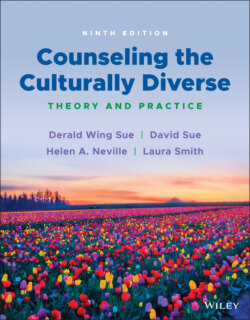Читать книгу Counseling the Culturally Diverse - Laura Smith L. - Страница 104
CONTEMPORARY FORMS OF OPPRESSION: RACISM, SEXISM & HETEROSEXISM
ОглавлениеMost people associate racism with blatant and overt acts of discrimination that are epitomized by hate crimes perpetrated by White Supremacist groups such as the Klan, Skinheads, Proud Boys, and Oath Keepers. Studies suggest, however, that more subtle and ambiguous forms of racism are just as detrimental (if not more so) than blatant expressions of bias because they are frequent, sometimes daily occurrences for People of Color (Sue, Capodilupo, et al., 2007; Sue & Spanierman, 2020). A similar statement can be made about sexism. Subtle sexism represents “unequal and unfair treatment of women that is not recognized by many people because it is perceived to be normative, and therefore does not appear unusual” (Swim, Mallett, & Stangor, 2004, p. 117). Whereas overt and covert sexism are intentional, subtle sexism is not deliberate or conscious. An example of subtle sexism is sexist language, such as the use of the pronoun he to convey universal human experience.
In many ways, subtle sexism contains many of the features that define aversive racism, a form of subtle and unintentional racism (Dovidio & Gaertner, 2000; Dovidio, Gaertner, & Pearson, 2017). Aversive racism is manifested in individuals who consciously assert egalitarian values but unconsciously hold antiminority feelings; therefore, “aversive racists consciously sympathize with victims of past injustice, support the principles of racial equality, and regard themselves as nonprejudiced. At the same time, however, they possess negative feelings and beliefs about historically disadvantaged groups, which may be unconscious” (Gaertner & Dovidio, 2006, p. 618).
Inheriting such negative feelings and beliefs about members of marginalized groups (e.g., People of Color, women, LQBTQ populations) is unavoidable and inevitable due to the socialization process in the United States (Sue, Calle, Mendez, Alsaidi, & Glaeser, 2021), where biased attitudes and stereotypes reinforce group hierarchy (Dovidio et al., 2017). Much like aversive racism, subtle sexism devalues women, dismisses their accomplishments, and limits their effectiveness in a variety of social and professional settings (Calogero & Tylka, 2014). Researchers have begun to underscore the importance of these daily experiences of subtle sexism, arguing that they are in fact harmful and need to be recognized as such (Becker & Swim, 2012; Cundiff, Zawadzki, Danube, & Shields, 2014).
Researchers have used the templates of modern forms of racism and sexism to better understand the various forms of modern heterosexism (Smith & Shin, 2014; Walls, 2008) and modern homonegativity (Morrison & Morrison, 2002). Heterosexism and antigay harassment have a long history and are currently prevalent in the United States. Studies find the following for LGBTQ persons in the workplace: (a) between 15% and 43% experience discrimination or harassment; (b) 7–41% report verbal or physical abuse or have had their workplace vandalized; and (c) 10–28% have not been promoted because they are gay or transgender (Burns & Krehely, 2011). Antigay harassment can be defined as “verbal or physical behavior that injures, interferes with, or intimidates lesbian women, gay men, and bisexual individuals” (Burn, Kadlec, & Rexler, 2005, p. 24). While antigay harassment includes comments and jokes that convey that LGBTQ individuals are pathological, abnormal, or unwelcome, it can also take more subtle forms (Burn et al., 2005). For example, blatant heterosexism would be calling a lesbian a dyke, whereas subtle heterosexism would be referring to something as gay to convey that it is stupid. For sexual minorities, hearing this remark may result in a vicarious experience of insult and invalidation (Burn et al., 2005; Marzullo & Libman, 2009). It may also encourage individuals to remain closeted, as the environment can be perceived as hostile.
The discriminatory experiences of transgender people have been very rarely studied in psychology (Nadal, Rivera, & Corpus, 2010), yet there is evidence to suggest that the pervasive daily discrimination faced by this population is associated with an elevated risk for suicide (Marzullo & Libman, 2009). One term used to define prejudice against transgender individuals is transphobia, “an emotional disgust toward individuals who do not conform to society's gender expectations” (Hill & Willoughby, 2005, p. 533). There is recent evidence to suggest that the microaggressions experienced by transgender individuals are distinct from those experienced by lesbian, gay, and bisexual people (Nadal, Skolnik, & Wong, 2012; Nadal, Griffin, Wong, Davidoff, & Davis, 2017).
What makes the phenomenon of racial, gender and LGBTQ microaggressions particularly complex is that ambiguity and alternative explanations obscure the true meaning of the behavior not only for the person who engages in it, but also for the person on the receiving end.
